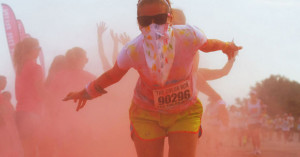
CineStill Launches Powdered ‘Just Add Water’ Film Developers
CineStill has launched new powdered versions of its color and black-and-white film development kits. The new "just add water" kits help photographers save both money and space.

CineStill has launched new powdered versions of its color and black-and-white film development kits. The new "just add water" kits help photographers save both money and space.

Toronto-based animal photographer Jess Bell has been shooting a wonderful series of photos showing dogs jumping and leaving colorful powder trails in their wake. The photos aren't the result of Photoshop compositing -- they were actually shot with dogs and powder.

When packing your gear bag for a two-week street photography trip, the last thing you might think to bring is an underwater housing. Most of the time you would be completely right to leave that item at home. But if your trip happens to be going to India during the celebration of Holi, an underwater housing may just be the protection you need.

The first known photograph was captured in 1826 when light reacted with a particular type of asphalt known as Bitumen of Judea. Since that first natural light photo, photographers have introduced artificial flash lighting to photos through all kinds of different ways. In this post, we're taking a look at a brief history of the camera flash -- from its humble beginnings with explosive powder and burning metal up through the latest LED lights -- to see how far it has come.

Photographer Jeffrey Vanhoutte of Brussels, Belgium was recently tasked with shooting a series of photos for a coffee creamer company. They ended up doing a mixed photo/video shoot with a professional acrobatic dancer flinging puffs of white powder into the air while doing dance moves.

Long before high-sync speedlights were ever a thing, there was a bleeding-edge technology that forever changed the way people photographed subjects. It was called magnesium flash powder.

When photographer Jana Cruder was commissioned to photograph the Aspen Santa Fe Ballet, she jumped at the opportunity to do something different -- something she felt would better express "the emotion and art of movement" that she witnessed when she saw them perform.
That something turned out to be copious amounts of colored corn starch.

If there hasn’t been a Color Run 5k or 10k race near you, there probably will be soon. And with all that color, you certainly want to take some pictures, right? Not with your camera you don’t.

By his own admission, photographer Andrew McGibbon doesn't like using natural light. It's not that there's anything wrong with shooting natural light -- he's done it before when the situation called for it -- it's just that he prefers the wow factor that he knows he can get by experimenting with crazy lighting setups.
He wants to create "surreal" images, and so it makes sense that he would be the photog behind Super Colour, a series of psychedelic portraits taken by combing the effects of colored gels, paints, powder and sometimes water.

Photographer Philippe Echaroux tells us that he recently completed a photo shoot for a series he calls, "The Pigment Party". Echaroux's idea was to capture studio-lit portraits of models posing serenely amidst explosions of colorful powders. After covering the studio with tarps, hanging up a black backdrop, and setting up his lighting, Echaroux had his assistants toss pigment powders of various colors onto the model's face.
The behind-the-scenes video above offers a look at how it all went down.

German photographer Geraldine Lamanna has a great series of photographs titled "Powder Dance" that captures the elegance and powder of dance using white powder. Inspired by the music video for the song "Rolling In The Deep" by Adele, Lamanna coated dance instructor Olivia Maciejowski and two her dance students with powder, and then had them bust out their moves for the camera. The resulting photographs are meant to show "echoes" of the movement.

Tech companies often like to create mini-documentaries featuring creatives who use their products -- last year both Intel and Brother made videos about fashion photographer Scott Schuman (The Sartorialist).

Maurice Ribble of Tech Photo Blog recently found the ingredients list for flash …